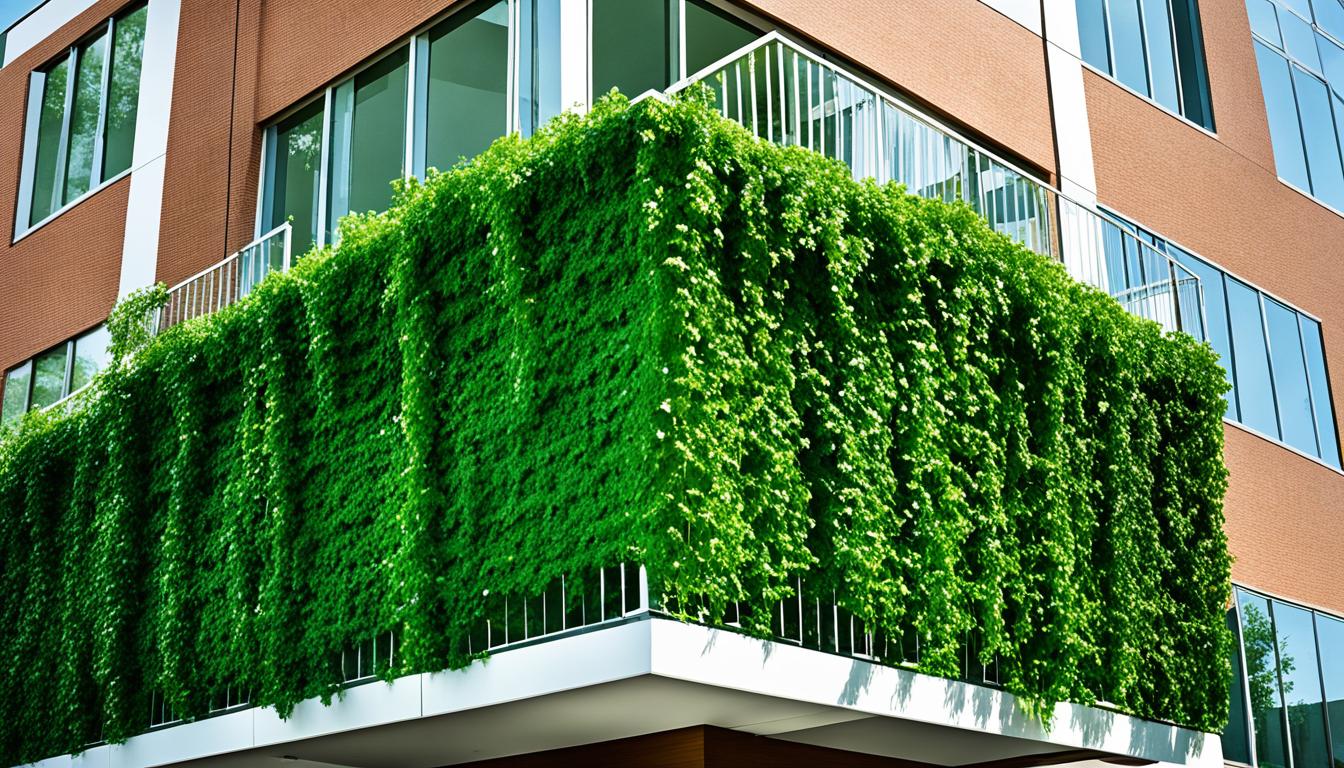Welcome to the guide on growing ivy in apartments. Ivy makes your space beautiful and elegant. This guide is for everyone. It has all you need to grow ivy inside.
Ivy brings nature into your home. It has pretty vines and leaves. But, ivy needs proper care. We will show you how to pick the right pot and soil. We’ll also teach you about light, water, pruning, and more. This helps your ivy stay healthy.
Key Takeaways:
- Choose the right pot and soil for your ivy plant.
- Provide adequate light conditions, preferably bright, indirect light.
- Water your ivy plant regularly and adjust watering based on its needs.
- Fertilize your ivy to promote healthy growth.
- Prune and maintain your ivy plant to keep it in optimal condition.
Next, we will learn more about ivy. We’ll talk about its benefits for apartments. We’ll discuss its air-cleaning ability, if it’s safe for pets, and how to grow it indoors. Let’s learn how to grow ivy in your apartment!
Why Do We Love Ivy for Apartments?
Ivy is loved for its beauty in apartments. It makes our homes look green and pretty.
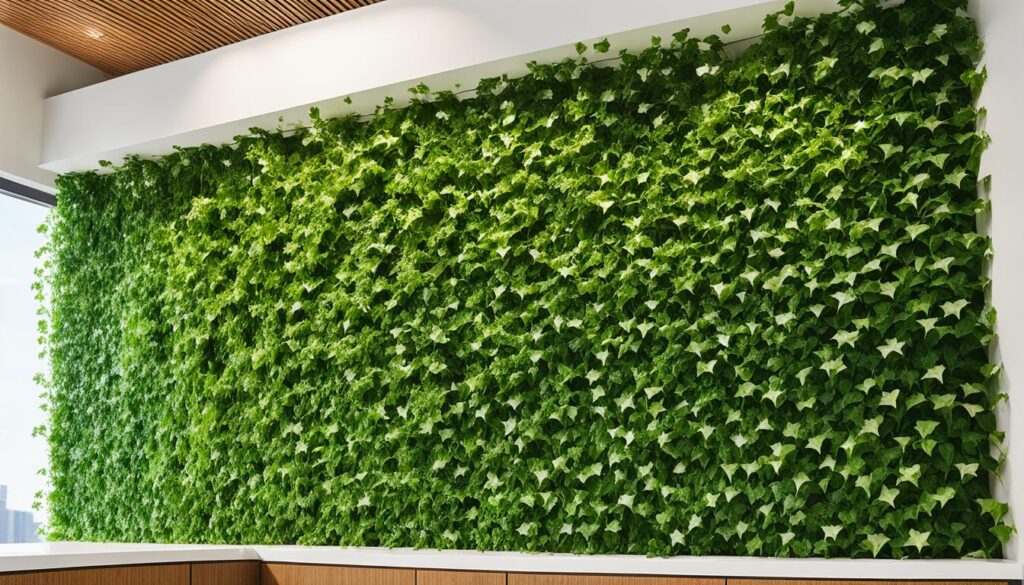
Is Ivy Air-Purifying?
Many people adore ivy because it cleans the air. Ivy removes harmful toxins, making the air better.
With ivy, your home feels fresher and healthier.
Is Ivy Pet Friendly?
Ivy is usually safe for pets like cats and dogs. But, eating too much can upset their stomachs.
Always watch your pets around ivy to avoid problems.
How Big Does Ivy Get?
Ivy size can change based on its type. Some ivies are small, fitting well in tiny places.
Others can grow big and need more space. Pick the right type for your apartment.
How to Grow Ivy – Learn to Grow this Indoor Beauty
Growing ivy indoors needs care and attention. We’ll guide you through all the steps. You’ll learn about choosing the right pot and soil, adequate light, watering and humidity, fertilization, pruning and maintenance, propagation, and dealing with pests and diseases.
Choosing the Right Pot and Soil
It’s important to pick the right pot and soil for indoor ivy. Choose a pot with holes to prevent root rot. The soil should drain well but hold moisture and be rich.
Providing Adequate Light
Ivy needs bright, but not direct, light. Place it near a window with filtered sunlight. Or use a grow light. Direct sun can harm the leaves.
Watering and Humidity
Water your ivy when the soil’s top inch is dry. Make sure extra water can drain out. Ivies like moist air. Try a humidifier or a water tray with pebbles.
Nutrition and Fertilization
Use a balanced fertilizer every 4-6 weeks in the growing season. Follow the package’s instructions to avoid harm. Too much fertilizer can hurt your ivy.
Pruning and Maintenance
Prune your ivy to keep it in shape and encourage growth. Remove bad leaves and long vines. Clean the leaves from dust regularly.
Propagation
You can make new ivies from stem cuttings or division. Cut a healthy vine under a node. Put it in water or soil until it roots. Then pot it. Or divide a big ivy into smaller ones, each with roots.
Monitoring for Pests and Diseases
Check your ivy for pests and sickness often. Look for aphids, spider mites, and others. Yellow leaves, stickiness, or webs mean problems. Treat quickly to protect your ivy.
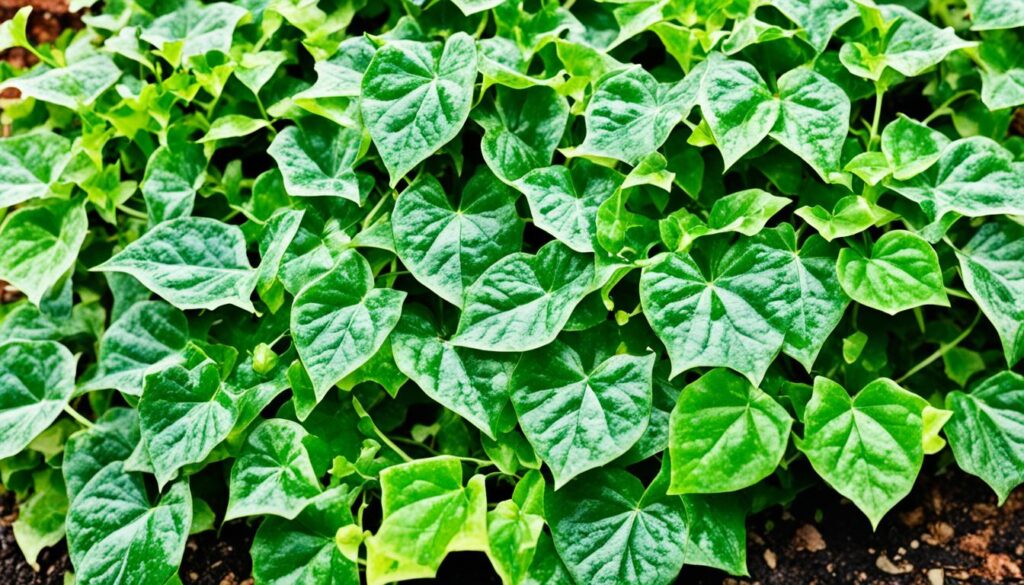
Appearance of Ivy
Ivy plants make any space look nice. They come in different shapes and colors. Some have pointy leaves while others have patterns. Ivy grows up walls and other things using its roots.
Take a look at the image below to see the diverse leaf shapes and colors of ivy plants:

| Leaf Shape | Leaf Color |
|---|---|
| Heart-shaped | Green |
| Triangular | Dark green |
| Oval | Variegated (green and white) |
| Pointed | Yellow-green |
As you can see, ivy leaves have different shapes like heart-shaped, triangular, oval, and pointed. They also have many colors. These include greens and green with white. Thanks to this, ivy plants are great for decorating indoors.
Light Requirements for Ivy
Ivy plants adjust well to different light. They like bright, indirect light the most. Knowing what light they need helps them grow indoors. We will look into ivy light needs and which types do well in less light.
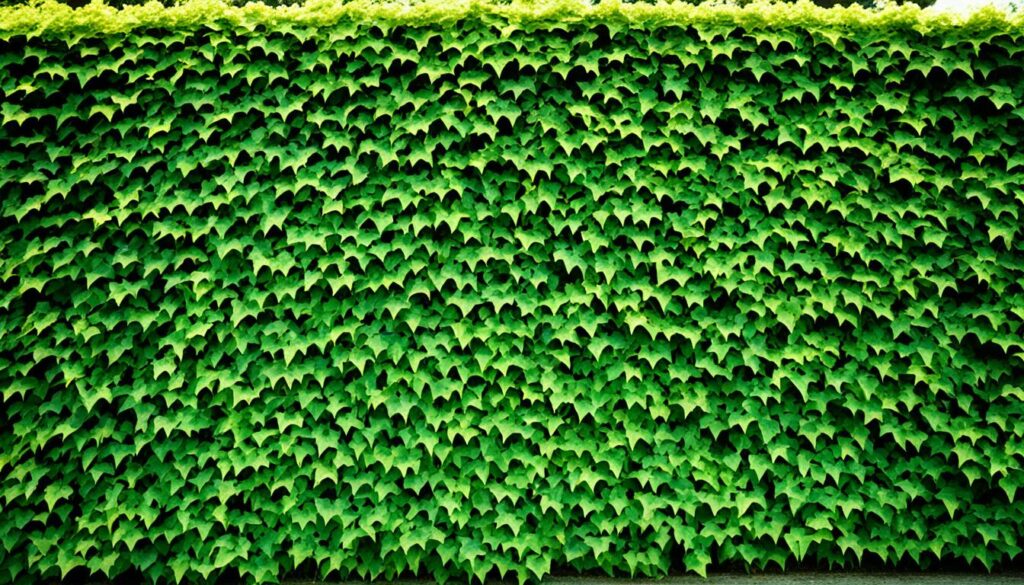
Indoor Light Conditions for Ivy:
Put your ivy near a window with bright, filtered sunlight. But, keep it away from direct sun to avoid leaf burn.
If your place is dim, artificial lights like fluorescent or LED can help your ivy. Different ivy types want different amounts of light. For example, English Ivy and Devil’s Ivy deal well with less light. They are good for dark spots.
Low Light Ivy Varieties:
| Variety | Scientific Name | Light Requirements |
|---|---|---|
| English Ivy | Hedera helix | Tolerates low light conditions |
| Devil’s Ivy | Epipremnum aureum | Thrives in low light environments |
| Heart-leaf Philodendron | Philodendron hederaceum | Adapts well to low light conditions |
These ivy types are great for places without much natural light. Like rooms with north-facing windows or spots away from windows.
Watch your ivy to make sure it gets enough light. Pale leaves or little growth mean it needs more light. Yellow or burnt leaves mean too much light.
Knowing ivy light needs and choosing right kinds can make your indoor space beautiful. Even in low-light areas, your ivy can thrive.
Watering Requirements of Ivy
Watering is key for your ivy plants’ health. It helps them grow well.
How Often to Water Ivy
Many things affect how often to water ivy. This includes the weather and pot size.
Water ivy when the soil’s top inch is dry. Too much water can harm them.
Signs of Overwatering Ivy
Too much water shows some clear signs. Look out for these:
- Yellowing or browning leaves
- Wilting, even when the soil is moist
- Mold or fungus growth on the soil surface
- A foul odor coming from the soil
Seeing these signs means you should water less. Let the soil dry first.
Signs of Underwatering Ivy
Not enough water is bad too. You might see these signs:
- Wilting and drooping leaves
- Dry and brittle leaves
- Leaf yellowing and crispiness
If you see these, water your ivy more. Make sure the soil gets moist.
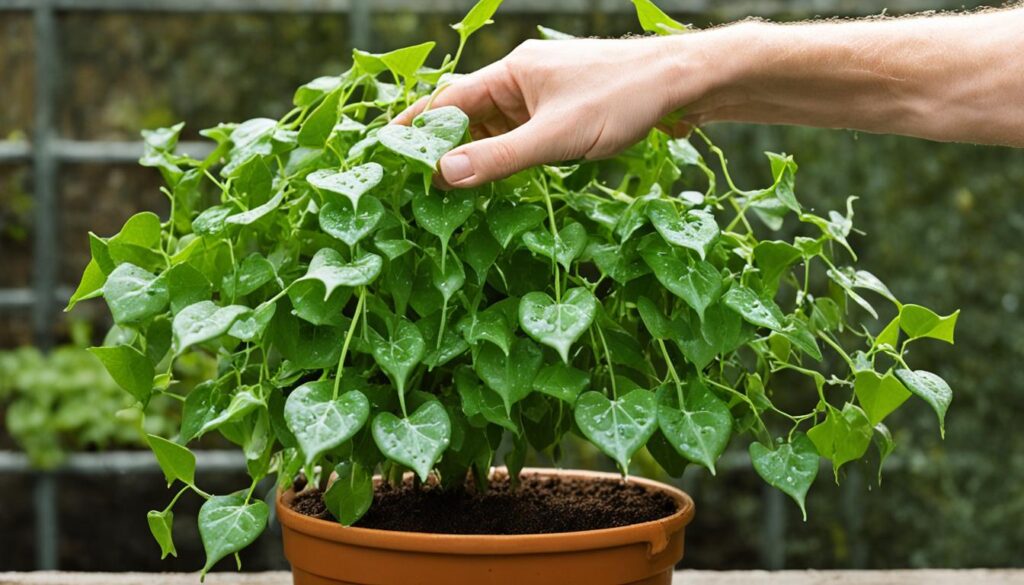
Watch the soil and your ivy’s signs. This way, you can water them right.
It’s better to water less than too much. Ivy likes it a bit dry.
| Signs of Overwatering Ivy | Signs of Underwatering Ivy |
|---|---|
| Yellowing or browning leaves | Wilting and drooping leaves |
| Wilting, even when the soil is moist | Dry and brittle leaves |
| Mold or fungus growth on the soil surface | Leaf yellowing and crispiness |
| A foul odor coming from the soil |
Fertilizing Ivy
Fertilizing your ivy is very important. It helps them grow healthy and look good. You should know what kind of food they need and how often. This will make your ivy happy and beautiful.
Recommended Fertilizer for Ivy
Choosing the right food for your ivy is key. Use a balanced fertilizer, like 10-10-10 or 14-14-14. These numbers mean the food has everything your plant needs.
You can also use a slow-release fertilizer. It feeds your ivy over time. This is very good for them.
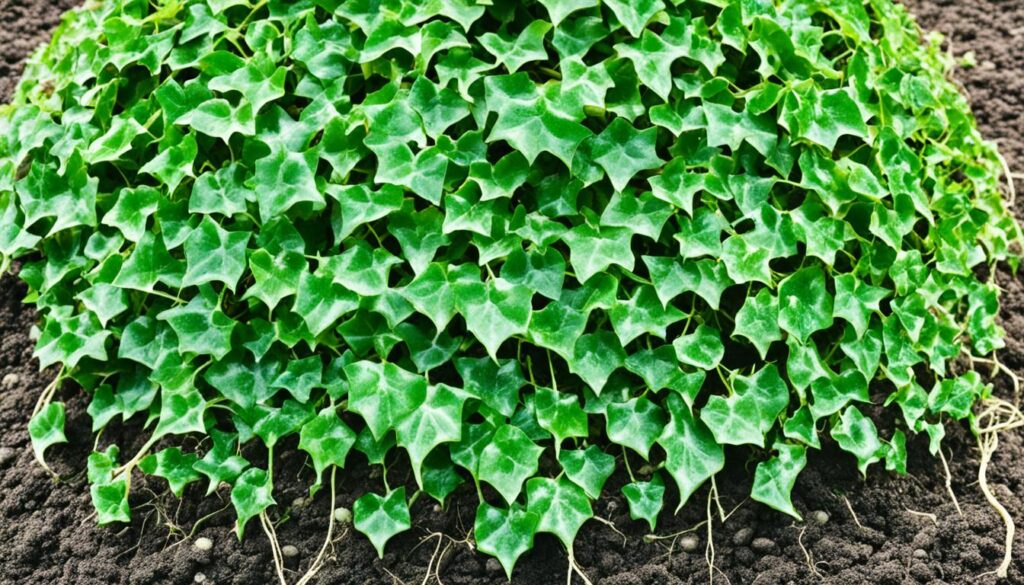
How Often to Fertilize Ivy
Ivy needs food regularly in spring to fall. This is when they grow the most. It’s good to feed them every four to six weeks.
But don’t give them too much. Too much food can hurt your ivy. Always check the package for how much to use.
Feeding your ivy right, along with water, light, and care, makes them beautiful. They will make your indoor space look great.
Potting Ivy
Potting ivy plants right is key for them to grow well and stay healthy. You’ll learn how to pick the correct pot, the best soil, and when it’s time to repot.
Choosing the Right Pot Size
Choosing the right pot size is important. Too small, and the roots can’t grow. Too big, and the roots might rot from too much water.
Look at your ivy’s current size. Pick a pot that’s 1-2 inches bigger. This gives the roots room without too much space. Once you’ve selected the appropriate pot, ensure it has drainage holes to prevent water from pooling at the bottom, which can lead to root rot. Remember to use a well-draining potting mix, as this will help maintain the health of your ivy. For additional insights on caring for your plants, consider checking out some golden pothos care tips to keep your greenery thriving.
Using the Right Potting Mix for Ivy
The potting mix is crucial for ivy’s success. It must drain well but keep some moisture.
A mix of peat moss, perlite, and potting soil is best. It drains well, lets air in, and keeps water. This helps roots grow strong without drowning.
Repotting When Necessary
Ivy needs repotting if it’s too big for its pot or if the soil drains poorly.
Signs to repot include roots coming out of the pot, not growing much, or water staying on top of the soil after watering.
Take the plant out carefully, untangle the roots, and put it in a bigger pot with new soil. Be gentle with the roots.
Ivy is usually repotted every 1-2 years, best in the spring. This lets ivy get ready for growing season.
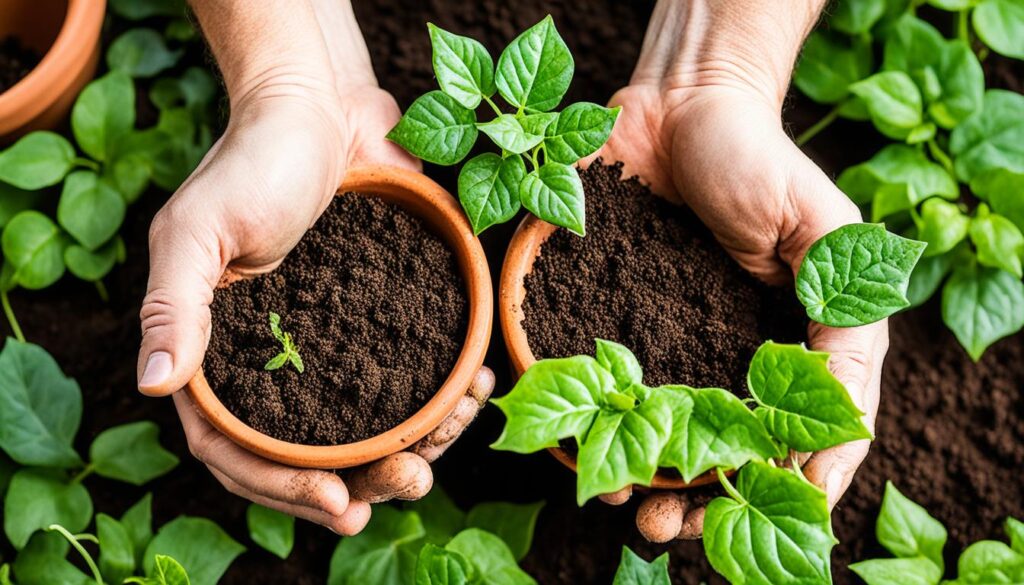
| Pot Size | Ideal Ivy Plant Size | Recommended Repotting Frequency |
|---|---|---|
| 4-6 inches | Small to medium | Every 1-2 years |
| 8-10 inches | Medium to large | Every 2-3 years |
| 12 inches or larger | Large | Every 3-4 years |
Picking the right pot and soil, and knowing when to repot helps ivy plants thrive indoors.
Propagating Ivy
Propagating ivy is a fun way to make your plant collection bigger. You can also share ivy with others. You can use stem cuttings, seeds, or division to propagate ivy. Division means splitting one big ivy plant into several small ones.
Stem Cuttings or Seeds?
Stem cuttings are a common way to grow new ivy. Take a piece from a healthy plant. Let it root and grow. Stem cuttings are easy and often work well. Choose a healthy stem and root it properly to get new plants.
Seed propagation is another method. It’s slower and needs patience. But, growing ivy from seeds is rewarding. Collect seeds from mature plants. Get them ready to sprout. Care for them well, and they will grow into lovely ivy plants.
Division of Ivy
Division works for big or crowded ivy plants. Split the plant into smaller pieces, each with roots. This way, you get several plants from one. You can pot them separately or plant them in your garden.
To divide an ivy, take it out of its pot or loosen the soil. Look for natural splits or cut it carefully. Make sure each piece has roots. Plant these pieces in new spots. Give them the care they need to grow well.
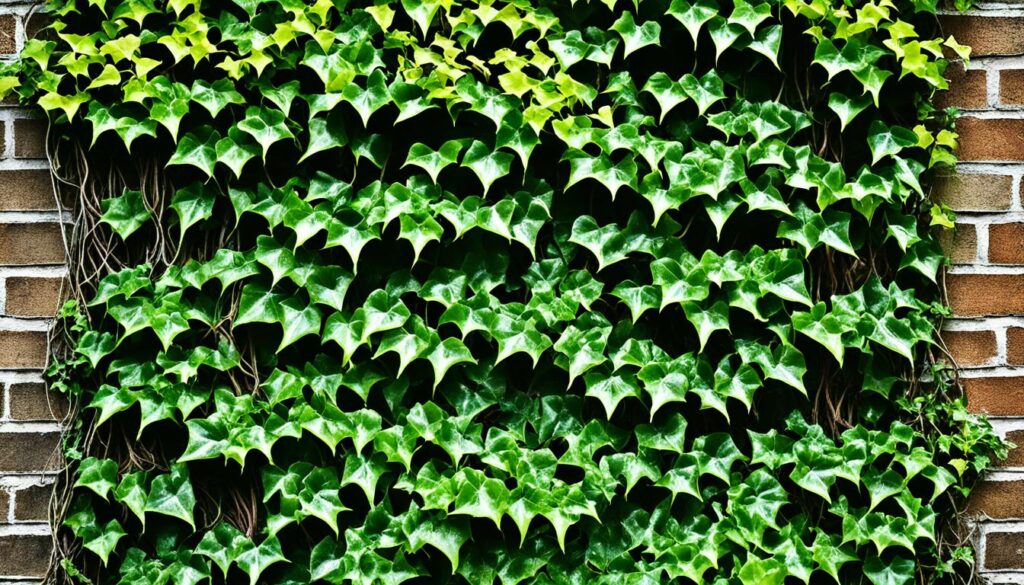
Propagate ivy through cuttings, seeds, or splitting. This lets the plant keep growing and spreading. Pick any method, but focus on doing it right. This will help your new ivy plants do great.
Growth and Development of Ivy
It’s vital to understand how ivy plants grow. This helps keep them healthy and looking good. Ivies move through different growth phases. Each phase needs its own care.
Ivy grows at varying speeds. This depends on light, warmth, and how you care for them. Some ivies grow fast, others slow. Knowing your ivy’s growth speed helps you look after it well.
Ivies can live from a few years to many decades. Good care ensures they live long, making spaces green and lovely. Yet, their lifespan varies. It depends on their health and where they are.
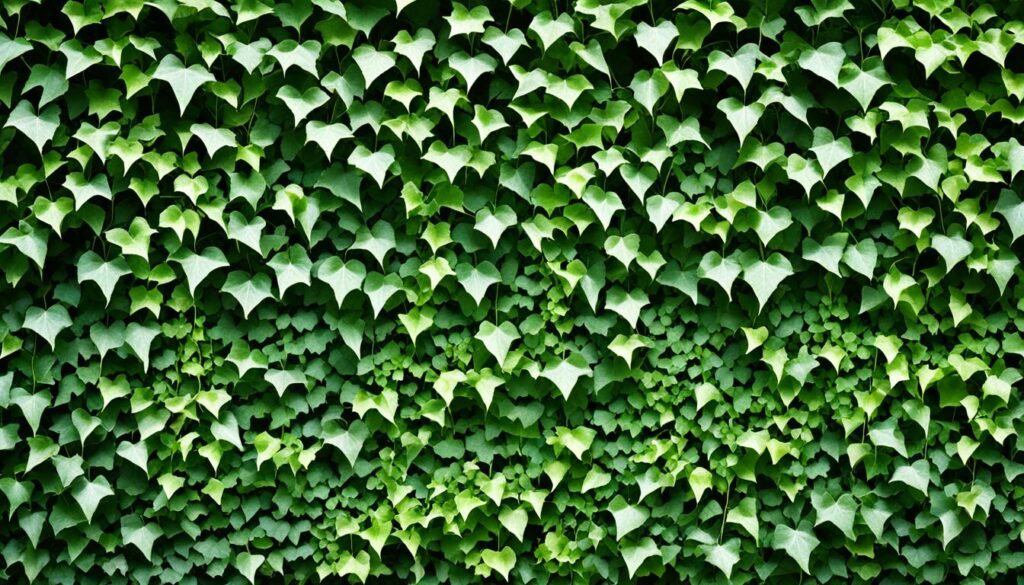
Watching your ivy’s growth is important for its health. Knowing about growth phases, speed, and lifespan helps. With the right care, your ivy will grow well in your space.
| Growth Stage | Description |
|---|---|
| Seedling Stage | The initial stage after germination, when the ivy plant develops its first set of leaves and establishes its root system. |
| Vegetative Stage | The period of active leaf and stem growth, where the ivy plant produces new foliage and forms a dense, cascading or climbing structure. |
| Mature Stage | The phase when the ivy plant reaches its full size and develops its characteristic leaf shape and coloration. It is during this stage that the plant may flower and produce berries. |
Dealing with Pests and Diseases in Ivy
Ivy can get sick from pests and diseases. This can make it grow poorly. Knowing about these problems helps you keep your ivy healthy. You can use good care to make your ivy strong and live a long time.
“Prevention is better than cure.” – Desiderius Erasmus
Pests:
Ivy attracts different pests, such as:
- Aphids: These small, soft-bodied insects feed on the sap of ivy leaves.
- Mealybugs: Mealybugs are tiny, white insects that leave a powdery residue on the leaves.
- Spider Mites: These tiny arachnids can cause damage by sucking sap from ivy leaves.
- Scale Insects: Scale insects appear as tiny, oval-shaped bumps on the stems and leaves of ivy plants.
Diseases:
Ivy can also get sick from various diseases, including:
- Leaf Spot: Leaf spot is characterized by circular or irregularly shaped spots on the leaves, often accompanied by a yellowing or browning of the surrounding tissue.
- Root Rot: Root rot is caused by excessive moisture, leading to decay and deterioration of the ivy plant’s roots.
- Powdery Mildew: This fungal disease appears as a white, powdery substance on the leaves, stems, and flowers of ivy plants.
Pest Control:
Check your ivy often for pests. This helps you spot problems early. Here’s what you can do:
- Pruning: Remove infested parts of the ivy plant and discard them to prevent the further spread of pests.
- Natural Predators: Encourage natural predators, such as ladybugs or lacewings, that feed on pests like aphids and mealybugs.
- Biological Pest Control: Use natural insecticides or soaps specifically formulated for controlling pests on ivy plants.
- Chemical Treatment: In severe cases, chemical treatments may be necessary. Consult a professional or follow the instructions on the product carefully when using chemical pesticides.
Disease Prevention:
To avoid diseases, take good care of your ivy. Here’s how:
- Proper Watering: Avoid overwatering to prevent root rot and ensure adequate drainage.
- Air Circulation: Provide proper air circulation by spacing out ivy plants and avoiding overcrowding.
- Cleanliness: Regularly clean and remove fallen leaves and debris to minimize the risk of disease spread.
- Healthy Growth Conditions: Maintain ideal growing conditions, including proper light exposure and temperature.
Note: If you’re unsure about your ivy’s problems, ask a plant expert for help.
| Pest/Disease | Description | Treatment |
|---|---|---|
| Aphids | Small, soft-bodied insects that feed on sap. | Pruning, natural predators, or natural insecticides. |
| Mealybugs | Tiny, white insects that leave a powdery residue. | Pruning, natural predators, or natural insecticides. |
| Spider Mites | Small arachnids that suck sap from leaves. | Pruning, natural predators, or natural insecticides. |
| Scale Insects | Small, oval-shaped bumps on stems and leaves. | Pruning, natural predators, or natural insecticides. |
| Leaf Spot | Circular or irregular spots on leaves, yellowing or browning. | Pruning affected leaves, improved airflow. |
| Root Rot | Decay and deterioration of roots due to excessive moisture. | Improving drainage, reducing watering. |
| Powdery Mildew | White, powdery substance on leaves, stems, and flowers. | Pruning affected parts, fungicidal treatment. |
Common Ivy Pests
To keep ivy plants healthy, know the pests they face. Here are some common ones:
Ivy Aphids: These tiny bugs eat ivy sap. Their feasting makes leaves curl and turn yellow. Look under leaves for small green or black bugs.
Mealybugs on Ivy: Mealybugs are small and soft. They leave white, cottony stuff on ivy. They can make ivy wilt, turn yellow, and stop growing right.
Spider Mites on Ivy: Spider mites are tiny pests on ivy. They make leaves speckled, yellow, and dry. They also spin fine webs on the plant.
Scale Insects on Ivy: Scale insects are small, oval pests. They suck ivy sap. You’ll see tiny bumps on leaves and stems. They make ivy yellow and wilt.
Check your ivy plants often for these pests. If you find bugs, take steps to get rid of them.
| Pest | Description | Signs of Infestation |
|---|---|---|
| Ivy Aphids | Small insects that feed on sap | Curled and yellowing leaves, clusters of small green or black bugs on undersides of leaves |
| Mealybugs on Ivy | Small, soft-bodied insects with a cottony residue | Wilting, yellowing, stunted growth, white cottony residue on the plant |
| Spider Mites on Ivy | Tiny pests that create fine webbing on the plant | Speckled, yellow, and dried-out leaves |
| Scale Insects on Ivy | Small, oval-shaped pests that feed on sap | Yellowing, wilting, tiny bumps on leaves and stems |
By acting early and fighting off pests, you can keep your ivy plants happy and healthy.
Natural Predators
Natural predators can help control pests on ivy plants. By adding certain organisms to your garden or inside, you can manage pests without chemicals. Let’s look at some natural predators that help with ivy pests.
Isolate Infected Plants
If your ivy plants have pests, you must keep them away from healthy ones. This stops the pests from spreading to other plants. Check your ivy often for pests and separate the sick plants quickly.
Chemical Treatment
In bad pest cases, you might need chemicals. But, you should be careful and follow the directions to protect the environment and your plants. Use products made for ivy pests the right way. Always put your safety, your plants’, and nearby good organisms first.
| Pest | Natural Predator |
|---|---|
| Ivy Aphids | Ladybugs, lacewings, parasitic wasps |
| Mealybugs on Ivy | Mealybug destroyers, ladybugs |
| Spider Mites on Ivy | Phytoseiulus persimilis, predatory mites |
| Scale Insects on Ivy | Ladybugs, parasitic wasps, predatory beetles |
Adding these predators to your ivy area helps control pests. Remember, natural predators might not get rid of all pests. So, keep an eye out and act if needed. Using natural predators, care, and checks, you can keep your ivy healthy and beautiful.
Disease Prevention for Ivy
Keeping your ivy plants healthy is very important. To do this, you must prevent diseases. You can protect your ivy by caring for it properly and taking steps to keep it safe.
Good care of your ivy is important. Here’s what you should do:
- Watering: Water your ivy the right way. Don’t water too much or too little. Keep the soil’s moisture just right to stop diseases.
- Light: Give your ivy the light it needs. The right light keeps it growing strong and healthy. It helps fight off diseases.
- Fertilization: Use the right fertilizer to feed your ivy. This keeps it healthy and strong enough to resist diseases.
- Pruning: Cut off any bad parts of your ivy. This keeps diseases away and helps new, healthy parts grow.
There are also extra steps to keep your ivy safe from diseases:
- Cleanliness: Keep your ivy clean. Wipe the leaves to remove dust and bits. This stops pests and sickness from getting to your plants.
- Air Circulation: Make sure your ivy has enough air around it. Good air stops too much moisture, which diseases like.
- Quarantine: When you get new plants, keep them away for a bit. This helps you spot any diseases before they spread.
- Plant Inspection: Always check your ivy for signs of being sick. If you find something early, you can stop it from getting worse.
Use these tips to care for your ivy. You can keep your ivy plants looking great at your place.
Tips for Maintaining Ivys
Keeping ivy plants healthy needs regular care. Follow easy tips to keep your ivy vibrant.
Wiping Leaves
It’s important to clean ivy leaves often. Dust and dirt can block sunlight. Use a soft cloth to gently wipe each leaf. This helps your ivy grow well and stay fresh.
Outdoor Exposure
Ivy plants love some time outside too. Try to put them outside for a bit each day. They get healthier with sunlight and air. But, watch out for hot sun and cold. Slowly get your ivy used to the outside. Pick spots with some shade.
Adjusting Watering Schedule
Watering right is key for ivy health. Ivy’s water needs change with the weather and air. Water more when it’s hot or dry indoors. Water less when it’s cool or humid. Check the soil often. Change how much you water to keep your ivy happy.
These tips help keep your ivy beautiful. Clean the leaves, give them outside time, and water right. With love and care, your ivy will grow well inside your home or apartment.
Tips for Successful Overwintering of Ivy
Keeping ivy plants alive in the cold can be hard. But with the right care, you can keep your ivy safe from the cold. This will help it stay well during the winter.
Here are some easy ways to keep your ivy safe in winter:
- Bring the ivy indoors: Move your outdoor ivy inside before the first cold snap. Place it where it gets enough light, like near a window that faces south.
- Protect from drafts: Ivy doesn’t like cold drafts. Keep them away from places that are drafty. This means staying clear of doors and windows.
- Adjust watering: Ivy needs less water in winter. Don’t water too much, that can hurt the roots. Wait for the top soil to dry before watering again.
- Monitor humidity: Winter air inside can be dry because of heaters. To help your ivy, spray its leaves with water or use a humidifier.
- Provide indirect light: Ivy likes light, but not too direct. Keep them near a window but away from direct sun. This prevents their leaves from getting burned.
- Inspect for pests: Check your ivy for bugs before bringing it inside. If you find any, deal with them first. This keeps your home pest-free.
By doing these things, your ivy can make it through winter. Keep looking after it and checking on it. This helps it stay healthy and beautiful.
Growing Ivy from Seed
Want to start an ivy plant from the start? Growing ivy from seeds is great. You get to see your plant grow from a tiny seed to a big plant. Just a little patience and care will let you grow ivy from seeds. You’ll feel great seeing your plant grow from the very start.
First, you need to get some ivy seeds. You can get seeds from big ivy plants. These plants have berries with seeds inside. Take the seeds out of the berries and keep them ready.
To make the seeds grow well, you need to get them ready. Wash the seeds with warm water to clean them. Don’t use strong cleaners or rub too hard. That can hurt the seeds. After cleaning, scratch the seeds a little. This helps them soak up water and food better.
Now it’s time to plant the seeds. Use a tray or pot with good dirt. Make the dirt a little wet but not too much. Put the seeds on top of the dirt. Press them down so they touch the dirt well.
Then, cover the tray or pot with clear plastic. This makes a mini greenhouse. It keeps the air moist. Put the tray somewhere warm but not in direct sun. Too much heat is bad for the seeds.
In the next few weeks, keep the dirt moist. Use a spray to add water if it gets dry. But don’t add too much water. Too much water can cause fungus and make the seeds rot. Waiting for seeds to sprout takes time. It can be a few weeks or months. It depends on the ivy type and the weather.
When the seeds sprout, you will see small plants coming up. Now, take off the plastic. Put the tray where there is light but not direct sun. Slowly let the plants get used to more light.
As the plants get bigger, move them to their own pots. Use good dirt. Take good care of them. This guide will tell you how to water, give light, and feed your plants. If you take care of them well, your ivy plants will grow big and beautiful. They will make your home look green and lovely.
Varieties of Ivy
Ivy plants come in many kinds. Each one is unique and beautiful. Let’s look at some popular ivy types for indoors:
English Ivy
English Ivy (Hedera helix) is very common. It has small to medium green leaves. This ivy grows fast and can climb walls. It likes different light conditions. People love it for its classic look.
Variegated Ivy
Variegated Ivy (Hedera helix ‘Variegata’) has green and white leaves. It’s really eye-catching. This ivy likes bright light but can also do well in less light. It’s great for adding color indoors.
Algerian Ivy
Algerian Ivy (Hedera canariensis) has big, shiny leaves. It grows fast and covers areas quickly. The leaves are deep green and thick. It likes bright light and more humidity. Algerian Ivy is good for a tropical look inside.
There are many types of ivy. Each one adds something special to a room. Think about light, growth, and look when picking an ivy. The right ivy makes your space beautiful.

